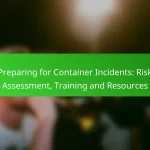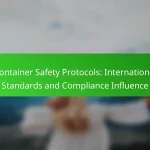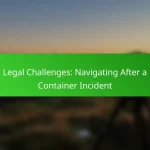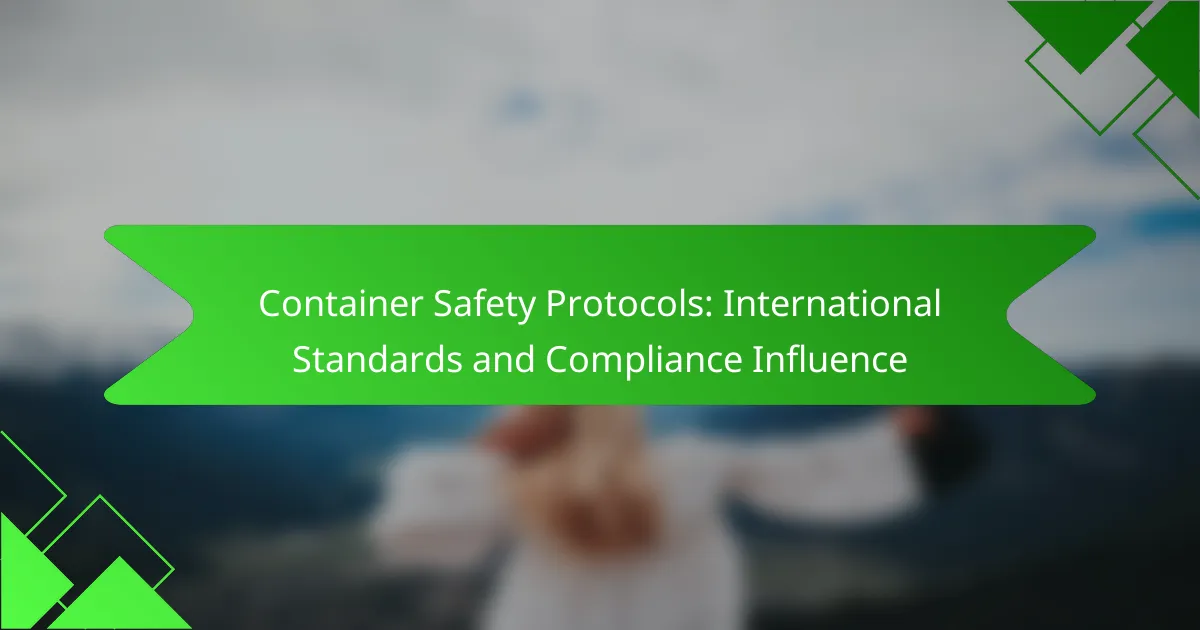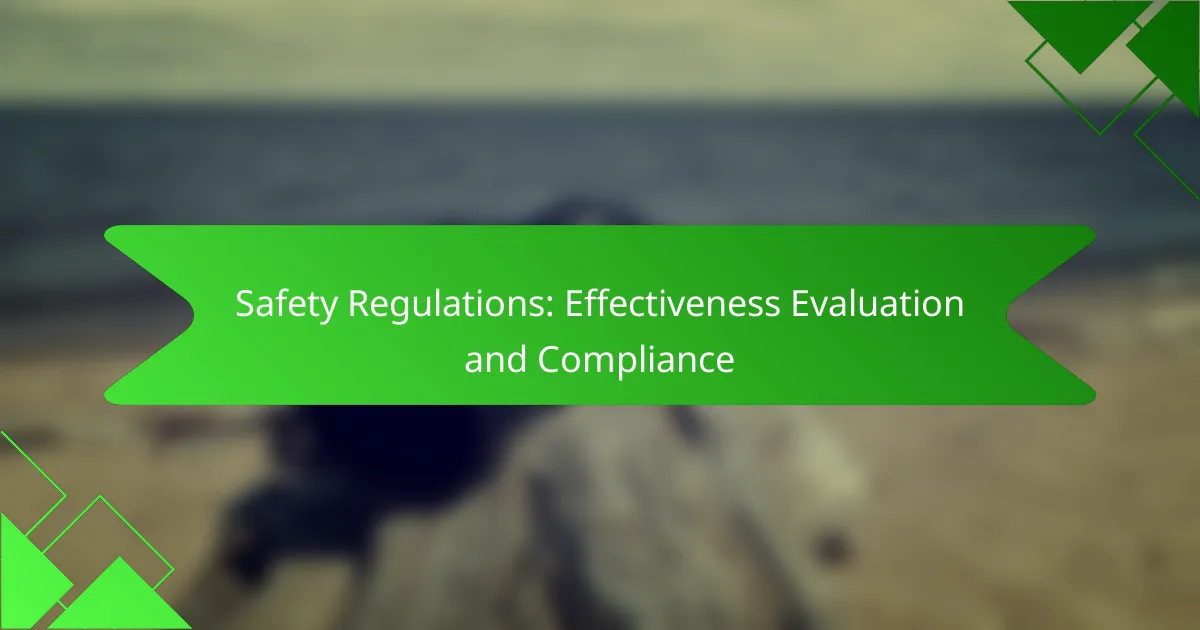Container safety protocols are essential for the secure handling, transport, and storage of shipping containers, aimed at reducing risks associated with containerized cargo. Compliance with international regulations not only standardizes safety practices but also ensures that containers are designed and maintained to protect both people and the environment. Implementing best practices, such as regular inspections and personnel training, further enhances safety and compliance in maritime operations.
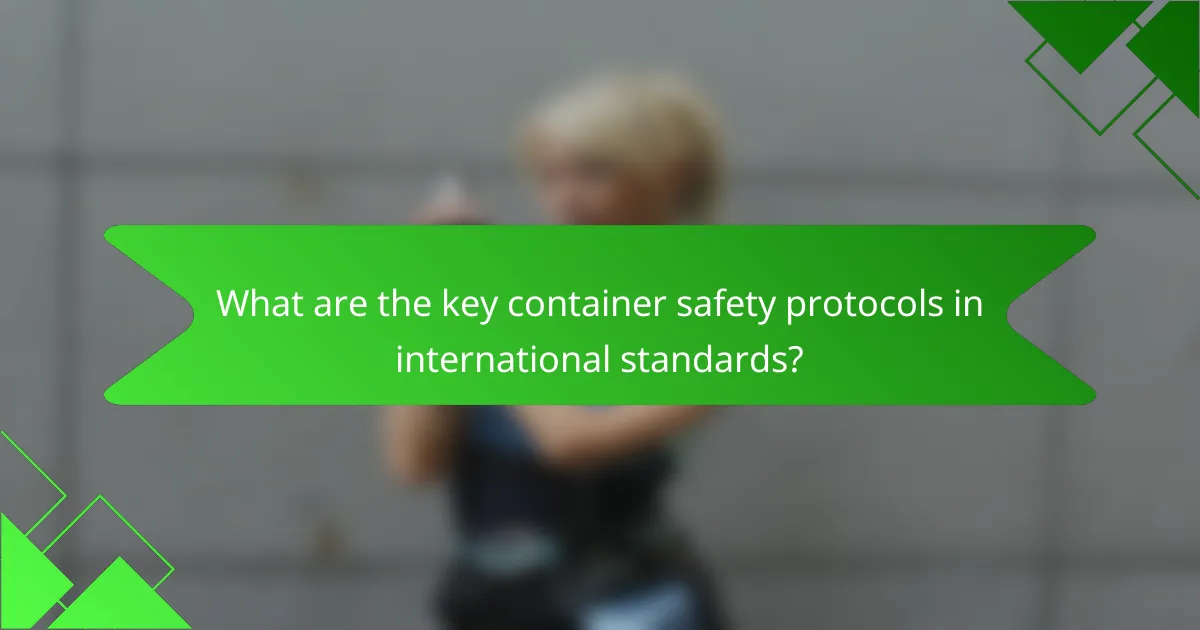
What are the key container safety protocols in international standards?
Key container safety protocols in international standards focus on ensuring the safe handling, transport, and storage of shipping containers. These protocols are designed to minimize risks associated with containerized cargo and enhance overall safety in maritime operations.
ISO 3874:2018 for container handling
ISO 3874:2018 outlines the requirements for the handling of containers, emphasizing safe practices during loading, unloading, and transport. This standard provides guidelines for container design, testing, and operational procedures to ensure safety and efficiency.
Implementing ISO 3874:2018 involves training personnel on proper handling techniques and using appropriate equipment, such as cranes and forklifts, that comply with the standard. Regular audits and inspections help maintain compliance and identify potential hazards.
CSC certification requirements
The Convention for Safe Containers (CSC) mandates that all shipping containers must meet specific safety standards and obtain CSC certification. This certification ensures that containers are structurally sound and capable of withstanding the rigors of transport.
To achieve CSC certification, containers must undergo rigorous testing, including structural integrity assessments and operational safety evaluations. Regular inspections are required to maintain certification, ensuring that containers remain compliant throughout their operational life.
IMO guidelines for container safety
The International Maritime Organization (IMO) provides guidelines for container safety that focus on the safe stowage and securing of containers on vessels. These guidelines aim to prevent accidents during transit and protect both cargo and crew.
Key aspects of IMO guidelines include proper weight distribution, securing methods, and regular inspections of securing devices. Adhering to these guidelines helps mitigate risks associated with container movement and enhances safety during maritime operations.
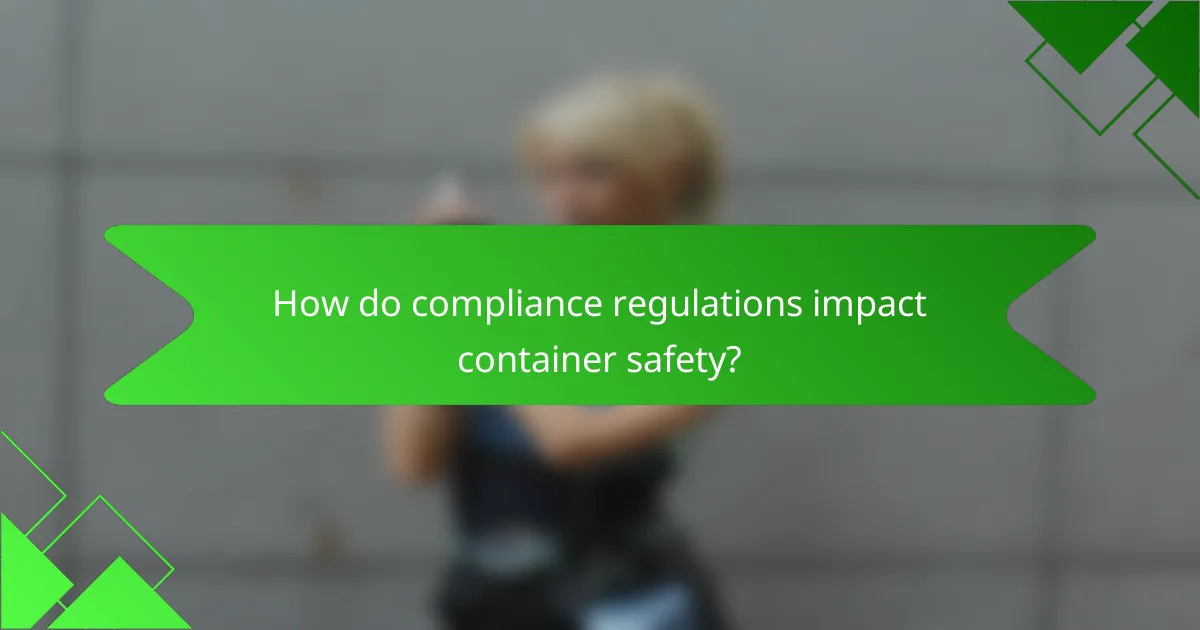
How do compliance regulations impact container safety?
Compliance regulations significantly enhance container safety by establishing standardized practices and protocols that must be followed. These regulations ensure that containers are designed, maintained, and operated in a manner that minimizes risks to people and the environment.
Impact of SOLAS regulations
The International Convention for the Safety of Life at Sea (SOLAS) sets forth critical safety standards for container shipping. These regulations mandate that containers are properly packed, secured, and labeled, which helps prevent accidents during transport.
For example, SOLAS requires the verification of container weights before loading, which reduces the risk of cargo shifts that could lead to accidents at sea. Compliance with SOLAS can also influence insurance premiums and liability in case of incidents.
Effects of national safety laws
National safety laws complement international regulations by addressing specific local conditions and risks. Countries may implement additional requirements that reflect their unique geographical and operational challenges, such as stricter inspections or enhanced training for personnel handling containers.
For instance, in the European Union, regulations may require more frequent safety audits and compliance checks compared to other regions. Companies operating internationally must stay informed about these laws to ensure full compliance and avoid penalties.

What are the best practices for ensuring container safety?
Best practices for ensuring container safety include implementing regular inspections, providing thorough training for personnel, and utilizing advanced safety technology. These practices help minimize risks and ensure compliance with international safety standards.
Regular inspection schedules
Establishing regular inspection schedules is crucial for maintaining container safety. Inspections should occur at defined intervals, such as weekly or monthly, depending on usage and regulatory requirements. This proactive approach helps identify potential issues before they escalate.
During inspections, focus on checking structural integrity, securing mechanisms, and any signs of wear or damage. Keeping detailed records of inspections can aid in compliance and provide a history of maintenance for each container.
Training programs for personnel
Comprehensive training programs for personnel are essential for promoting container safety. Employees should be trained on proper handling techniques, emergency procedures, and the use of safety equipment. Regular refresher courses can help reinforce knowledge and adapt to any changes in safety protocols.
Consider incorporating hands-on training sessions and simulations to enhance learning. This practical experience can significantly improve response times in emergency situations and ensure that all staff are well-prepared.
Use of safety technology
Utilizing safety technology can greatly enhance container safety. Implementing tracking systems, such as GPS or RFID, allows for real-time monitoring of container conditions and locations. This technology can alert personnel to any unauthorized movements or environmental changes that may compromise safety.
Additionally, consider investing in smart sensors that monitor temperature, humidity, and structural integrity. These devices provide valuable data that can help prevent accidents and ensure compliance with safety regulations.

What are the challenges in maintaining container safety?
Maintaining container safety involves navigating various challenges that can compromise the integrity and security of cargo. Key issues include inconsistent global regulations and technological limitations that hinder effective monitoring and compliance.
Inconsistent global regulations
One of the primary challenges in container safety is the lack of uniform regulations across different countries. Each nation may have its own set of standards for container design, handling, and inspection, leading to confusion and potential safety risks.
For instance, while the International Maritime Organization (IMO) sets certain guidelines, local regulations can vary significantly. This inconsistency can complicate compliance for shipping companies operating internationally, often resulting in increased costs and delays.
Technological limitations
Technological limitations also pose significant challenges to container safety. Many existing systems for tracking and monitoring containers are outdated or lack integration capabilities, making it difficult to ensure real-time visibility and control over cargo.
For example, while GPS tracking is widely used, it may not provide complete data on container conditions such as temperature or humidity. Investing in advanced technologies like IoT sensors can improve safety but may require substantial upfront costs and training.

How can companies improve compliance with container safety standards?
Companies can enhance compliance with container safety standards by adopting structured management systems and conducting regular assessments. These practices ensure that safety protocols are consistently followed and that any potential issues are identified and addressed promptly.
Implementing compliance management systems
Establishing a compliance management system involves creating a framework that outlines safety procedures, responsibilities, and reporting mechanisms. This system should be tailored to meet international standards such as ISO 9001 or specific industry regulations relevant to container safety.
Key steps include training employees on safety protocols, documenting procedures, and utilizing software tools to track compliance metrics. Regular updates to the system are essential to reflect changes in regulations or operational practices.
Regular audits and assessments
Conducting regular audits and assessments is crucial for maintaining compliance with container safety standards. These evaluations help identify gaps in safety practices and ensure adherence to established protocols.
Companies should schedule audits at least annually and consider unannounced checks to gauge real-time compliance. Utilizing checklists can streamline the audit process, focusing on critical areas such as container integrity, labeling, and handling procedures.

What role does technology play in container safety?
Technology plays a crucial role in enhancing container safety by providing real-time monitoring, data analytics, and automation. These advancements help in identifying potential hazards, ensuring compliance with international standards, and improving overall operational efficiency.
Use of IoT for monitoring
The Internet of Things (IoT) significantly improves container safety by enabling continuous monitoring of environmental conditions and structural integrity. Sensors can track temperature, humidity, and vibrations, alerting operators to any anomalies that may compromise safety.
Implementing IoT solutions involves installing sensors on containers and connecting them to a centralized system for data analysis. This allows for proactive measures to be taken, such as adjusting temperature settings for sensitive cargo or rerouting containers showing signs of damage.
Common pitfalls include neglecting regular maintenance of IoT devices and failing to ensure data security. To maximize effectiveness, companies should establish a routine for sensor checks and invest in cybersecurity measures to protect sensitive information.
